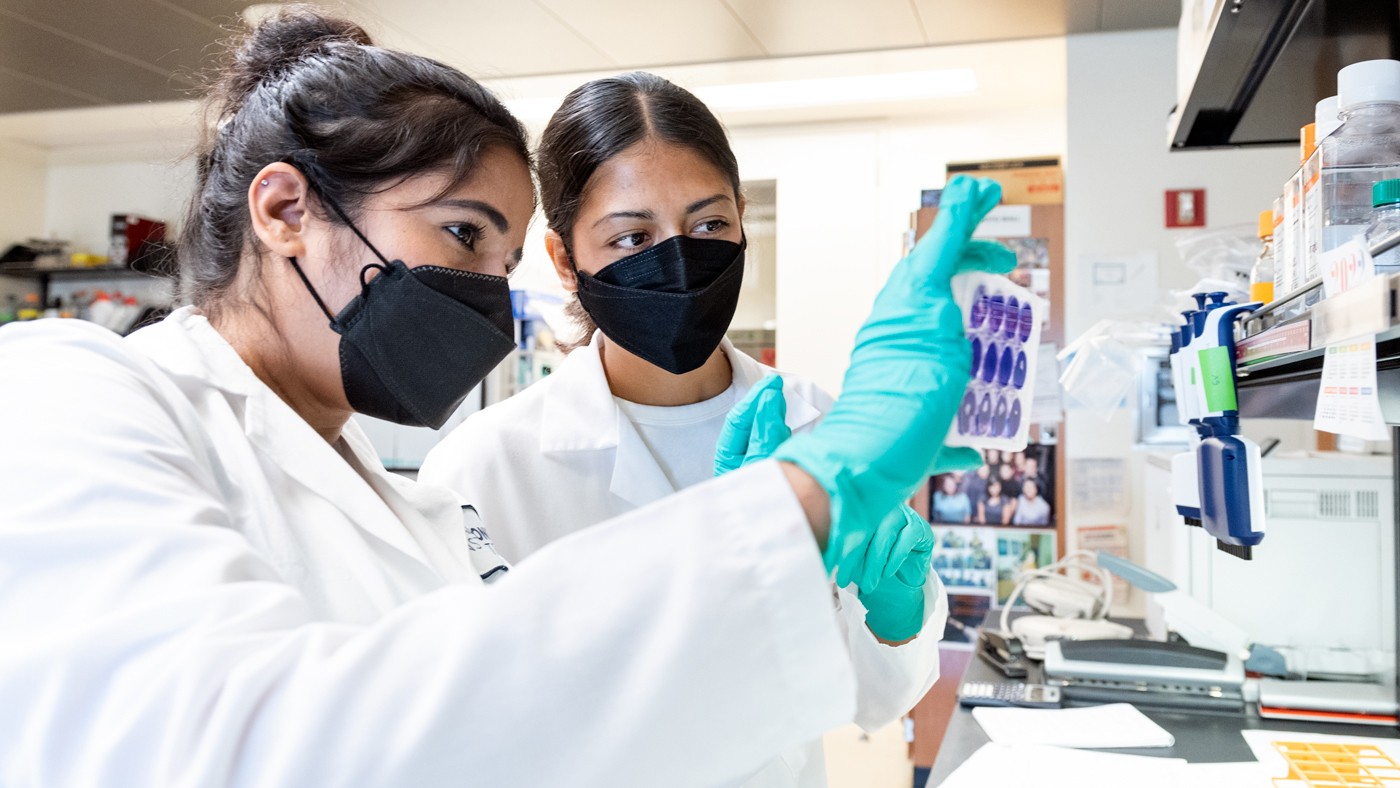Gladstone NOW: The Campaign Join Us on the Journey✕

Sonali Chaturvedi (left) and her colleagues in Leor Weinberger's lab show that a new single-dose intranasal treatment for SARS-CoV-2 infection decreases viral shedding and limits transmission of the virus. Seen here with Daniela Lopez (right).
By the time you test positive for COVID-19, the SARS-CoV-2 virus has already taken up residence in your respiratory system. With each breath, you expel invisible viral particles into the air—a process known as viral shedding. Existing drugs aimed at treating COVID-19, even when they address symptoms of the virus, do little to quell viral shedding.
Researchers at Gladstone Institutes previously developed a novel approach for treating infectious diseases: a single-dose, intranasal treatment that protects against severe SARS-CoV-2 infection.
In a new study published in Proceedings of the National Academy of Sciences, they show that this new treatment, called a therapeutic interfering particle (TIP), also decreases the amount of virus shed from infected animals and limits transmission of the virus.

Chaturvedi is the first author of a new study describing the only single-dose antiviral that reduces COVID-19 symptoms and severity, as well as viral shedding.
“Historically, it has been exceptionally challenging for antivirals and vaccines to limit the transmission of respiratory viruses, including SARS-CoV-2,” says Gladstone Senior Investigator Leor Weinberger, PhD, senior author of the new paper. “This study shows that a single, intranasal dose of TIPs reduces the amount of virus transmitted, and protects animals that came into contact with that treated animal.”
“To our knowledge, this is the only single-dose antiviral that reduces not only symptoms and severity of COVID-19, but also shedding of the virus,” says Sonali Chaturvedi, PhD, a research investigator at Gladstone and first author of the paper.
A Drug that Evolves
Viruses like SARS-CoV-2, as well as influenza and HIV, evolve over time, becoming resistant to drugs and making it difficult to develop long-lasting treatments. More than two decades ago, Weinberger first proposed the idea of therapeutic interfering particles (TIPs) to treat viruses; rather than directly target a portion of a virus, TIPs compete for resources in an infected cell. By hogging the replication machinery inside a cell, they can keep the virus from churning out more copies of itself.
“TIPs would be an ideal treatment for SARS-CoV-2 infection because they keep learning as the virus evolves, so they could keep the problem of drug resistance in check.”
The benefit of TIPs, though, goes beyond their ability to stifle a virus inside infected cells. Because TIPs reside inside the same cells as the virus they target, they evolve at the same time, staying active even as new viral strains emerge.
“Over the last few years, many of the challenges of the pandemic have been related to the emergence of new variants,” says Chaturvedi. “TIPs would be an ideal treatment because they keep learning as the virus evolves, so they could keep the problem of drug resistance in check.”
Prior to the COVID-19 pandemic, Weinberger’s group was already developing TIPs to treat HIV. In 2020, they quickly pivoted to SARS-CoV-2, developing a single-dose TIP against the virus that can be delivered intranasally.
Last year, they reported that, in rodents, TIPs could successfully block multiple different variants of SARS-CoV-2, reducing the viral load in the lungs by 100-fold and reducing many of the symptoms of COVID-19.
Stopping the Spread
In the new paper, Weinberger and Chaturvedi studied whether TIPs could also reduce viral shedding—a separate question from reducing symptoms and viral load.
The researchers treated hamsters infected with SARS-CoV-2 with the antiviral TIPs and then measured, daily, the amount of virus in the animals’ noses. Compared to hamsters that hadn’t received the TIPs (called control animals), treated animals had less virus in their nasal passages at every time point. By day 5, all control animals were still shedding high levels of virus, while the virus was undetectable in four out of five TIP-treated animals.

Weinberger and his team are seeking FDA approval to test their new antiviral therapy in humans.
“We know that the amount of virus shed is proportional to how infectious someone is,” says Weinberger, who is also the William and Ute Bowes Distinguished Professor and director of the Center for Cell Circuitry at Gladstone. “If viral shedding can be reduced, the number of secondary contacts likely to become infected will also very likely be reduced, which will in turn decrease overall virus dissemination and help keep vulnerable individuals safe.”
When the SARS-CoV-2–infected animals were housed in cages with uninfected animals, treatment of the infected animals with TIPs did not fully prevent the transmission of COVID-19. However, it did lead to significantly lower viral loads and milder symptoms of infection in the newly exposed animals.
“This particular laboratory setting is known to generate much more efficient transmission than typically seen in humans, even in household settings, because the hamsters not only transmit via aerosols, but also through bodily fluids and by climbing over and grooming each other for many hours.” says Weinberger, who holds the title of professor of biochemistry and biophysics, and pharmaceutical chemistry at UC San Francisco. “So, being able to reduce SARS-CoV-2 transmission in this animal setting is quite promising for being able to reduce human-to-human transmission.”
While the initial experiments were done using the Delta strain of SARS-CoV-2, the researchers repeated the tests using the ancestral WA-1 strain of the virus and confirmed that the same TIPs were effective across variants.
Weinberger’s team is now seeking FDA approval for a clinical trial to test the TIPs in humans.
For Media
Julie Langelier
Associate Director, Communications
415.734.5000
Email
About the Study
The paper “A single-administration therapeutic interfering particle reduces SARS-CoV-2 viral transmission and pathogenesis in hamsters” was published in the journal Proceedings of the National Academy of Sciences on September 8, 2022.
Other authors are Michael Pablo, Gustavo Vasen, Xinyue Chen and Giuliana Calia of Gladstone; Nathan Beutler and Thomas Rogers of Scripps Research; Davey Smith of UC San Diego; and Lauren Buie and Robert Rodick of VxBiosciences, Inc.
The work was supported by Pamela and Edward Taft, the US Army Medical Infectious Disease Research Program (MTEC 2020-492), and the National Institutes of Health (DP1DA051144).
About Gladstone Institutes
Gladstone Institutes is an independent, nonprofit life science research organization that uses visionary science and technology to overcome disease. Established in 1979, it is located in the epicenter of biomedical and technological innovation, in the Mission Bay neighborhood of San Francisco. Gladstone has created a research model that disrupts how science is done, funds big ideas, and attracts the brightest minds.
Featured Experts
Support Our COVID-19 Research Efforts
Gladstone scientists are moving quickly to respond to the coronavirus outbreak. Help us end this pandemic.
Genomic Maps Untangle the Complex Roots of Disease
Genomic Maps Untangle the Complex Roots of Disease
Findings of the new study in Nature could streamline scientific discovery and accelerate drug development.
News Release Research (Publication) Marson Lab GenomicsSix Gladstone Scientists Named Among World’s Most Highly Cited Researchers
Six Gladstone Scientists Named Among World’s Most Highly Cited Researchers
The featured scientists include global leaders in gene editing, data science, and immunology.
Awards News Release Corces Lab Doudna Lab Marson Lab Pollard Lab Ye LabThe Genome Editing Playbook Is Different in Neurons
The Genome Editing Playbook Is Different in Neurons
The striking findings of a new study could influence how gene therapies are designed for many genetic diseases.
News Release Research (Publication) Neurological Disease Conklin Lab Doudna Lab CRISPR/Gene Editing




